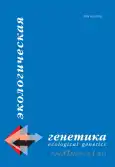DEVELOPMENTAL PATTERNS OF SNIFFING BEHAVIOR IN male laboratory MICE in conditions of SOCIAL COMPETITION
- Authors: Kleshchev M.A.1, Osadchuk L.V.1
-
Affiliations:
- Institute of Cytology and Genetics
- Issue: Vol 11, No 1 (2013)
- Pages: 36-41
- Section: Articles
- URL: https://journals.rcsi.science/ecolgenet/article/view/2393
- DOI: https://doi.org/10.17816/ecogen11136-41
- ID: 2393
Cite item
Full Text
Abstract
Full Text
##article.viewOnOriginalSite##About the authors
Maksim Aleksandrovich Kleshchev
Institute of Cytology and Genetics
Email: max82cll@ngs.ru
Junior Researcher, Group of Endocrine Genetics
Lyudmila Vladimirovna Osadchuk
Institute of Cytology and Genetics
Email: losadch@bionet.nsc.ru
Leading Researcher, Group of Endocrine Genetics
References
- Брагин А. В., Осадчук Л. В., Осадчук А. В., 2006. Экспериментальная модель формирования и поддержания социальной иерархии у лабораторных мышей // Журн. высш. нерв. деят. Т. 56, № 3. С. 412–419.
- Громов В. С., 2008. Пространственно-этологическая структура популяций грызунов. М.: Товарищество научных изданий КМК. 581 с.
- Кроукфорд П., 1970. Артур, Билл и другие (все о мышах). М.: Мир. 158 с.
- Кудрявцева Н. Н., 1987. Различия в реактивности мышей двух генотипов на зоосоциальные сигналы в тесте «перегородка» // Журн. высш. нерв. деят. Т. 37, № 5. С. 929–934.
- Кудрявцева Н. Н., 1989. Поведенческие корреляты агрессивной мотивации у самцов мышей // Журн. высш. нерв. деят. Т. 39, № 5. С. 884–889.
- Осадчук Л. В., Брагин А. В., Осадчук А. В., 2010. Межлинейные различия в социальном доминировании и временных паттернах агонистического поведения у самцов лабораторных мышей // Журн. высш. нерв. деят. Т. 59, № 4. С 473 –481.
- Панов Е. Н., 2010. Поведение животных и этологическая структура популяций. М.: Книжный дом Либроком. 424 с.
- An X., Zou J., Wu R., Yang Y.et al., 2011. Strain and sex differences anxiety-like and social behaviors C57BL/6J and BALB/cJ mice // Exp. Anim. Vol. 60. P. 111–123.
- Arakava H., Blanchard D. C., Arakawa K., Dunlap C. et al., 2008. Scent marking behavior as an odorant communication in mice // Neuroscience and Biobehavioral Reviews. Vol. 32. P. 1236–1248.
- Arakawa H., Cruz S., Deeak T., 2011. From models to mechanisms: odorant communication as a key determinant social behavior in rodents during illness-associated states. // Neuroscience and Biobehavioral Reviews. Vol. 35. P. 1916–1928.
- Bartolomucci A., Palansa P., Caspani L., Limiroli E. et al., 2001. Social status in mice: behavioral, endocrine and immune changes are context depended //Physiol. Behav. Vol. 73. P. 401–410.
- Bolivar V. J., Walters S. R., Phoenix J. L., 2007. Assessing autism-like behavior in mice: variations in social interactions among inbred strains // Behav. Brain Res. Vol. 176. P. 21–26.
- Brennan P. A., Kendrick К. M., 2006. Mammalian social odours: attraction and individual recognition //Phil. Trans. R. Soc. B. Vol. 361. P. 2061–2078.
- Chorelis E., Allen-Clipperton A. E., Phan A., Kavaliers M., 2009. Neuroendocrinology of social information processing in rats and mice // Frontiers in Neuroendocrinology. Vol. 30. P. 442–459.
- Desjardins C., Maruniak J. A., Bronson F. H., 1973. Social rank house mice: differentiation revealed by ultraviolet of urinary marking patterns // Nature. Vol. 20. P. 939–941.
- Drickamer L. C., 2001. Urine marking and social dominance in male house mice. (Mus musculus domesticus) // Behavioural Processes. Vol. 53. P. 113–120.
- Ferguson J. N., Young L. J., Insel T. R., 2002. The neuroendocrine basis of social recognition // Frontiers in Neuroendocrinology. Vol. 23. P. 200–224.
- Gabor C. S., Phan A., Clipperton-Allen A. E., Kavaliers M. et al., 2012. Interplay of oxytocin, vasopressin, and sex hormones in the regulation of social recognition // Behav. Neurosci. Vol. 126. P. 97–109.
- Hayashi S., 1993. Development and diversity of social structure in male mice // J. Ethol. Vol. 77. P. 77–82.
- Hurst J. L., Beynon R. J., 2004. Scent wars: the chemobiology of competitive signaling in mice // Bioessays. Vol. 26. P. 1288–1298.
- Keverne E. B., 2002. Mammalian pheromones: from genes to behavior // Curr. Biol. Vol. 12. P. 807–809.
- Neumann С. Duboscq G. Dubuc C., 2011. Assessing dominance hierarchies: validation and advantages of progressive evaluation with Elo-rating // Anim. Behav. Vol. 82. P. 911–921.
- Ojeda S. R., Urbanski H. F., 1994. Puberty in the rat // The Physiology of Reproduction / Eds. Knobil E., Neill J. D. N. Y.: Raven Press Ltd. P. 363–409.
- Sankoorikal G. V., Kaercher K. A., Boon C. J., Lee J. K. et al., 2006. A mouse model system for genetic analysis of sociability: C57BL/6J versus BALB/cJ inbred mouse strains // Biol Psychiatry. Vol. 59. P. 415–423.
Supplementary files






